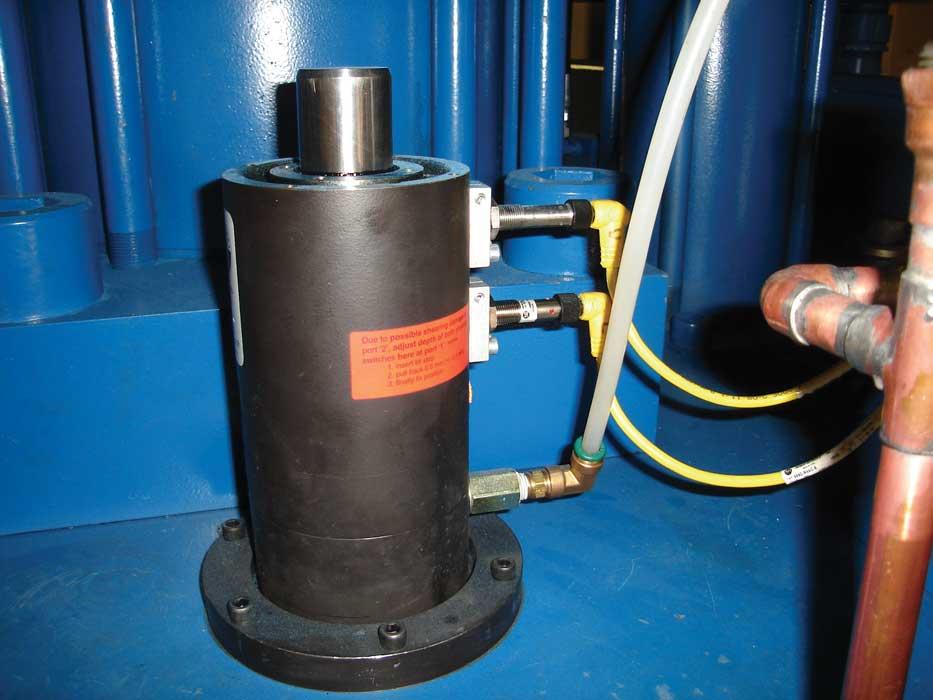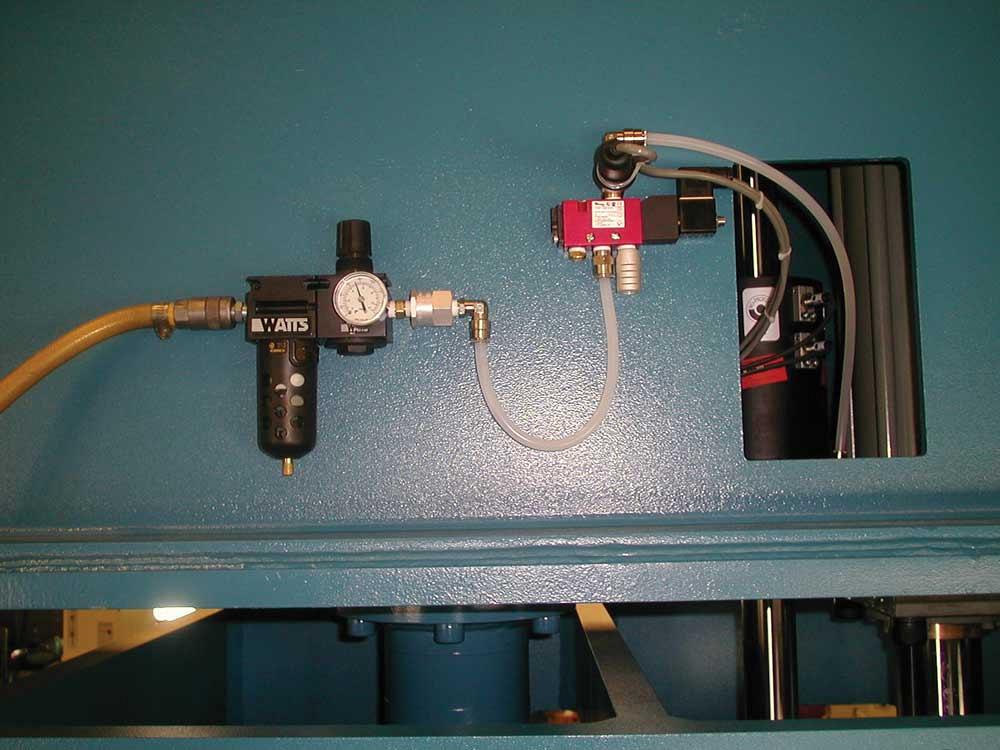Contributing editor
- FMA
- The Fabricator
- FABTECH
- Canadian Metalworking
Categories
- Additive Manufacturing
- Aluminum Welding
- Arc Welding
- Assembly and Joining
- Automation and Robotics
- Bending and Forming
- Consumables
- Cutting and Weld Prep
- Electric Vehicles
- En Español
- Finishing
- Hydroforming
- Laser Cutting
- Laser Welding
- Machining
- Manufacturing Software
- Materials Handling
- Metals/Materials
- Oxyfuel Cutting
- Plasma Cutting
- Power Tools
- Punching and Other Holemaking
- Roll Forming
- Safety
- Sawing
- Shearing
- Shop Management
- Testing and Measuring
- Tube and Pipe Fabrication
- Tube and Pipe Production
- Waterjet Cutting
Industry Directory
Webcasts
Podcasts
FAB 40
Advertise
Subscribe
Account Login
Search
Redundant safety systems: necessary or excessive?
How much is a second chance for safety worth?
- By Kate Bachman
- October 6, 2017
- Article
- Bending and Forming

A hydraulic load-holding clamp unit (shown) or a monitored mechanical load-holding system must be installed to meet the 6.5 Load Holding During Production requirement. Photo courtesy of Greenerd Press & Machine Co., Nashua, N.H.
Recent political rhetoric about scaling back “burdensome regulations” has been met with approval and even cheers by some manufacturing groups and business owners. A factory is built to produce—the more productive it is, the more profitable it is—and no business wants to be mired in reams of paperwork and costly conformance measures.
Redundant safety systems are landing under the microscope of those scouring regulations for rollback opportunities.
Hydraulic press builders and press owners have been working to meet American National Standards Institute (ANSI) standard B11.2-2013 Safety Requirements for Hydraulic and Pneumatic Presses regarding secondary load holding during production (see 6.5 Load Holding During Production sidebar). If a risk assessment indicates that an “unacceptable risk of injury” caused by unintended gravity fall of the slide exists, measures should be taken to install a monitored mechanical load-holding system, a secondary load-holding system, or a combination of the two.
While ANSI is not a regulatory agency, standards that ANSI prescribes often are the bellwether for future regulations. Many of the ANSI requirements are later cited by OSHA. Once a standard is implemented by OSHA, it then becomes a federal requirement. In addition, the standards often match regulations set by European safety regulatory agencies.
Like other redundant safety measures, ANSI standard B11.2 6.5 is a second chance for safety, so to speak. If ever there were a situation warranting second chances, safety would be one, wouldn’t it?
What constitutes an “unacceptable risk of injury”—or more to the point, what constitutes an acceptable risk of injury? Intuitive reasoning would dictate that there is no acceptable risk of injury, right? Yet, adding safety features and safeguards does not come free. Ultimately, adding safety measures adds cost to machinery and equipment, especially if they are done as a retrofit.
So where is the line?
ANSI Intent, Remedies
The intent of requiring a secondary load-holding system is to prevent an unintended gravity fall in the event of breakage of the cylinder rod connection to the slide; failure of the primary load-holding device; or single failure of the mechanical or hydraulic/pneumatic system, according to ANSI.
One type of hydraulic/pneumatic load-holding system that can be used is a separately mounted cylinder attached to the slide and machine frame that provides a slide arrest function. This system works in conjunction with the press safeguarding control system and engages the arrest cylinder in the event of a malfunction of the normal slide control system, ANSI states.
As to the location of the valve, “The intent of locating the valve as close as possible to the cylinder is to minimize the introduction of additional failure points. A common method includes the attachment of the valve directly to the cylinder,” the standard body reports.

This is a side view of a hydraulic/pneumatic load-holding system installed in the crown of the press with the pneumatic lines running to it. Photo courtesy of Greenerd Press & Machine Co.
The press should be designed so that the weight of the slide and attachments can be held in the event of a single failure of a main cylinder. If this is not possible, additional load-holding systems may be required.
Input
Several industry experts provided information and their perspectives.
Tim Wilson, design engineer with hydraulic press manufacturer Greenerd Press & Machine Co., Nashua, N.H., called the addition of monitored valves that allow verification of valve operation before the initiation of a cycle “a significant change.”
He said, “Monitored valves are less common than standard directional valves so they are more expensive and not as readily available. But that is changing,” he added.
There are several ways to accomplish secondary load holding to prevent the gravity fall of the platen if the cylinder rod connection were to fail, but all add cost to the press, he relayed.
The best way to determine the level of safety required is the requisite risk assessment per ANSI B11.0, he added.
“We always want to implement the safest practices possible, but they need to also be practical for the customer. On low-tonnage presses, the cost impact of following ANSI B11.2-2013 completely is significant. If it were required for all applications, a lot of our customers simply would not be able to afford new capital equipment,” Wilson said.
Wilson said that the voluntary aspect of ANSI standards is beneficial. “It gives the industry time to implement the changes until they are adopted by OSHA. Sometimes the standards use components that are not common in the industry. Time allows the manufacturers to develop products and implement them in a way that is best-suited for all involved.”
Matt Brenner, vice president of sales for Rockford Systems LLC, Rockford, Ill., said, “If a machine is retrofitted with a load-holding system and monitored valves, that equipment will most likely be controlled and monitored by our SSC-1500 series hydraulic press control.”
“I believe that these changes will likely reduce the risk of machine malfunction causing workplace injuries. In some cases, machines cannot be retrofitted because the framework was not designed to accommodate a load-holding system.”
Brenner said that if ANSI standards were mandatory for press builders, the load-holding system would be seamlessly integrated into the press. “The end user would pay more for the press upfront, but at least they wouldn’t be surprised by a large retrofitting project cost sometime after purchasing the machine.”
American National Standards Institute, www.ansi.org
B11 Standards, www.b11standards.org
Greenerd Press & Machine Co. Inc., www.greenerd.com
Rockford Systems LLC, www.rockfordsystems.com
6.5 Load Holding During Production
A risk assessment shall be conducted to determine if unacceptable risk of injury exists due to unintended gravity fall of the slide. If so, at least one of the following shall be incorporated in addition to the main tonnage cylinder:
a) a monitored mechanical load holding system;
b) a hydraulic/pneumatic load holding system in accordance with 6.5.1 or 6.5.2;
c) a combination of a single monitored valve hydraulic/pneumatic load holding system and a monitored mechanical load holding system.The risk assessment shall take into account the size and shape of the moving hazard in addition to the applied force. See ANSI B11.0.The load holding systems shall operate automatically and shall be effective throughout all portions of the cycle during all times that operators have access to the tools, pinch points, or danger zone. Each load holding system shall be individually capable of holding the slide and attachments.6.5.1 Single cylinder systems
For a single cylinder system, where a mechanical restraint is not used and unacceptable risk of injury from a gravity fall exists, the hydraulic / pneumatic load holding system shall consist of two separate holdup or return cylinders each with a monitored valve, capable of independently holding the slide and attachments.
6.5.2 Multiple cylinder systems
For multiple cylinder systems where a mechanical restraint is not used and unacceptable risk of injury from a gravity fall exists, the hydraulic/pneumatic load holding system shall consist of at least two monitored valves fitted as close as possible to the cylinder outlets of either:
- two of the main cylinders; or
- two separate holdup or return cylinders, each capable of independently holding the slide and attachments.
6.5.3 Load holding system failure
Load holding systems shall be interlocked to prevent a press stroke after any failure within the system.
Note: Standard provided by David Felinski of B11 Standards Inc.
About the Author

Kate Bachman
815-381-1302
Kate Bachman is a contributing editor for The FABRICATOR editor. Bachman has more than 20 years of experience as a writer and editor in the manufacturing and other industries.
subscribe now

The Fabricator is North America's leading magazine for the metal forming and fabricating industry. The magazine delivers the news, technical articles, and case histories that enable fabricators to do their jobs more efficiently. The Fabricator has served the industry since 1970.
start your free subscription- Stay connected from anywhere

Easily access valuable industry resources now with full access to the digital edition of The Fabricator.

Easily access valuable industry resources now with full access to the digital edition of The Welder.

Easily access valuable industry resources now with full access to the digital edition of The Tube and Pipe Journal.
- Podcasting
- Podcast:
- The Fabricator Podcast
- Published:
- 04/16/2024
- Running Time:
- 63:29
In this episode of The Fabricator Podcast, Caleb Chamberlain, co-founder and CEO of OSH Cut, discusses his company’s...
- Industry Events
16th Annual Safety Conference
- April 30 - May 1, 2024
- Elgin,
Pipe and Tube Conference
- May 21 - 22, 2024
- Omaha, NE
World-Class Roll Forming Workshop
- June 5 - 6, 2024
- Louisville, KY
Advanced Laser Application Workshop
- June 25 - 27, 2024
- Novi, MI































